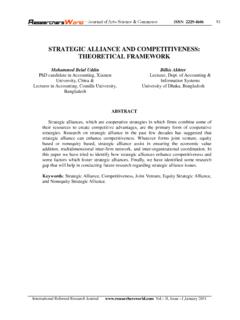Transcription of Understanding the Federated Model. A series of ...
1 Local Business Structures within a Federated ModelOrganizations need to consider how ready they are for change, whether they have the resources necessary to support the level of change they envision, and the risks and potential rewards n d e r s t a n d i n g t h e F e d e r a t e d M o d e l . A s e r i e s o f p u b l i c a t i o n s Table of ContentsEXECUTIVE SUMMARY ..3 Executive Summary ..4 Acknowledgements ..5 INTRODUCTION ..7 Background and goals of this research ..7 Overview of research methodology ..7 Terminology and language used in report ..7 REVIEW OF THE LITERATURE ..9 The environment and catalysts for strategic alliances ..10 Strategies for scaling out ..10 Approaches to scaling out ..10 Structures for scaling out ..12 Challenges to developing alliances and strategic restructurings.
2 14 The Process ..15 Key success factors, lessons learned and tips for achieving success ..16 KEY FINDING OF SLP S INDEPENDENT RESEARCH ..19 Environmental Trends driving structural change ..20 Challenges contributing to structural change in the sector ..21 Structural changes undertaken by local agencies of other Federated Organizations ..21 Landscape within the Big Brothers Big Sisters movement in Canada ..25 Structures utilized by Big Brothers Big Sisters local agencies in Canada ..27 Lessons learned from successful and difficult structural changes ..31 Conclusions and Recommendations ..35 Strategies for increasing effectiveness and impact ..37 Important factors to consider prior to scaling out ..37 Growth strategies or approaches to scaling out.
3 38 Organizational structures ..39 strategic alliances ..41 Recommendations for a successful transformation ..43A role for National in increasing organizational capacity within the Big Brothers Big Sisters movement in Canada ..44 BIBLIOGRAPHY ..45 APPENDIX I: RESEARCH METHODOLOGY (DETAILED DESCRIPTION) ..49 EXECUTIVE SUMMARYP repared by: Sue Dallhoff and Grace Bugg strategic Leverage Partners for: Bruce MacDonald, President & CEO Big Brothers Big Sisters of Canada - 4 - - 4 - - 5 - - 5 -Executive Summary Discussions about alliances and strategic restructurings are increasing in the nonprofit sector as organizations look for more effective ways to meet the needs of the communities they serve. Whether set in motion by a sudden change in the status quo, pressure from funders, or strategic plans that point to the need for more efficient and effective tactics, organizations are seeking better ways to organize themselves and leverage available resources.
4 While collaborations amongst nonprofit organizations have become increasingly common, many are short term in nature and built around available funding. Nonprofit organizations are becoming increasingly aware of the benefits of establishing strategic alliances that are relationship rather than grant based and involve active work on substantial issues on an ongoing basis. Some of these start out as informal collaborations and grow into more formal partnerships around programs and services. Some find the rewards so compelling that they decide to go further and cement the relationship by establishing management service organizations or Brothers Big Sisters of Canada has a long term goal of reaching 100,000 children, up substantially from current levels.
5 While Big Brothers Big Sisters of Canada agencies provide service to over 1,000 communities across the country, there are still many parts of Canada where children do not have access to Big Brothers Big Sisters programs and services. The larger agencies, which already serve beyond their immediate communities, are being approached to extend their reach into other communities. A number of smaller agencies either want to extend their reach or are struggling to maintain service. Many local leaders within the Big Brothers Big Sisters of Canada movement see the need for their organizations to evolve further in order to expand the number of children they serve. Today, agencies are more willing to talk about mergers and consider structural change as a means of meeting goals, and some agencies are actively looking at opportunities to partner and/or merge with others.
6 Greater collaboration with other youth serving organizations and NGOs is occurring as successful agencies are being asked by funders to take on leadership roles outside of the Big Brothers Big Sisters organization. As a result, these agencies are not only extending their reach within the Big Brothers Big Sisters of Canada network but are becoming more outward looking. There are numerous approaches to scaling out that allow varying degrees of autonomy and require varying degrees of integration. They range from loose alliances to those that require a change in corporate structure, such as mergers. They run the gamut from arrangements that involve a single community to those that extend to a region or province and involve affiliates of one related organization or many non-related organizations.
7 On the other hand, some of the most successful organizations stay small and create impact by aligning themselves with like minded, long term partners. Rather than scaling out using the approaches just discussed, they share more of a lateral relationship with other organizations to build capacity outside of their organizations and increase their impact beyond what they would be capable of on their own. Implementing alliances and integrations is not without its challenges. Most of these challenges are around human issues as organizations struggle with the fear of losing what they see as their uniqueness and the cost to their organizations in terms of time, energy, and resources. Organizations need to consider how ready they are for change, whether they have the resources necessary to support the level of change they envision, whether the change will be not only well received but supported by their stakeholders, and the risks and potential rewards involved.
8 Oftentimes, organizations have found that acquiring resources for scaling out is very different from acquiring resources for their original programs or services. As they look to the rewards, organizations also have to consider the downside to the community, the client, and the organization s reputation if things do not go as planned and find the best way to balance risk with reward. Experience tells us that the benefits to brand and knowledge often exceed expectations while economies of scale generally tend to disappoint at least initially. Given the cost involved, organizations can benefit from the lessons learned by others who have gone though structural change. By far the factor most often credited with success is keeping the mission front and centre.
9 Perhaps equally important is the inclusiveness of the process, trust, and the key role played by the leaders of the organizations involved. Those who have been through change also stress the importance of communication, organizational culture, the process for decision making, due diligence, planning, timing, patience, flexibility, and resources. This report attempts to provide some consistent language around the organizational structures utilized by Big Brothers Big Sisters of Canada agencies across the country and looks at the various structures available and how successful organizations have extended their services and broadened their client base to achieve greater impact. It also speaks to what the national organization can do to help facilitate growth within the Big Brothers Big Sisters movement in SUMMARY - 4 - - 4 - - 5 - - 5 -EXECUTIVE SUMMARYA cknowledgementsThe authors and Big Brothers Big Sisters of Canada would like to express their appreciation to the Muttart Foundation and an anonymous donor for their financial support of this research study.
10 They would also like to thank the many people who took the time to speak with the authors and share their experiences openly in order to assist others who are considering various options for scaling out as they consider how to best structure their operations for maximum impact. It was inspiring to hear the stories of how the leaders of the Big Brothers Big Sisters of Canada affiliates work so passionately in the best interests of the movement and their clients, the children in need. The candidness with which focus group members and key informants spoke about both the leaders who inspired themselves and the others and lessons learned through their own struggles is greatly appreciated. The authors would like to thank the participants of the Agency Services Team focus group: Renee Hebert, Rob Lewis, Joelle Lewis, Karen Shaver, and Allan Undheim; participants of the Metro Agencies focus group: Rhonda Brown, Cathy Denyer, Carol Goddard, Michelle Harrison, Shari Lyn Ladanchuk, Sharon Moore, Shannon Newman-Bennett, Marianne Noakes, Liz O Neill, Cathy Urqhart, and Moragh Wolfe.



